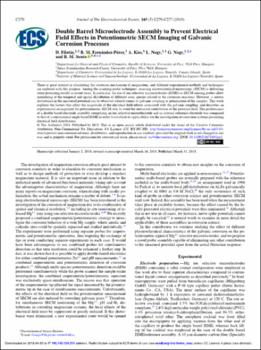Double barrel microelectrode assembly to prevent electrical field effects in potentiometric SECM imaging of galvanic corrosion processes
Fecha
2018Resumen
There is great interest in elucidating the corrosion mechanism of magnesium, and different experimental methods and techniques
are explored with this purpose. Among the scanning probe techniques, scanning electrochemical microscopy (SECM) is delivering
some promising results in recent years. In particular, the use of ion selective microelectrodes (ISME) as SECM sensing probes allow
monitoring of the temporal and spatial distribution of different ionic species related to the corrosion reactions. However, a serious
disturbance in the measured potential can be observed when it comes to galvanic coupling or polarization of the samples. This work
explores the factors that affect the magnitude of the electrical field effects associated with the galvanic coupling, and describes an
experimental arrangement for potentiometric SECM able to avoid the unwanted contribution of the potential field. The performance
of a double barrel electrode assembly comprising an ion selective microelectrode and an internal reference electrode was compared
to that of a conventional single barrel ISME in order to establish its applicability for the investigation of corrosion systems presenting
electrical field distributions.






